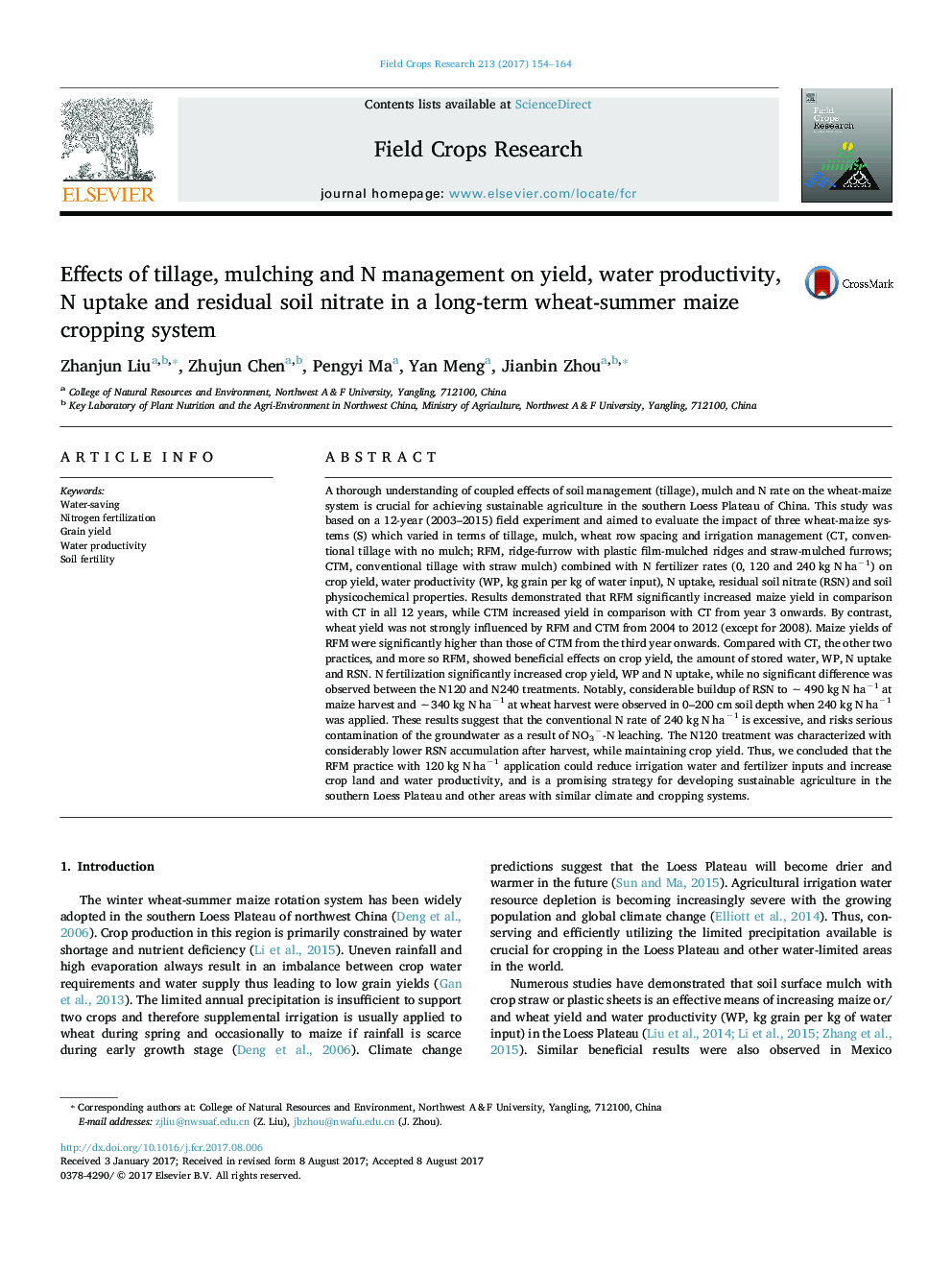| کد مقاله | کد نشریه | سال انتشار | مقاله انگلیسی | نسخه تمام متن |
|---|---|---|---|---|
| 5761418 | 1624650 | 2017 | 11 صفحه PDF | دانلود رایگان |
عنوان انگلیسی مقاله ISI
Effects of tillage, mulching and N management on yield, water productivity, N uptake and residual soil nitrate in a long-term wheat-summer maize cropping system
ترجمه فارسی عنوان
تأثیر عملکرد خاک ورزی، مالچ و نیتروژن بر عملکرد، بهره وری آب، جذب نیترات و نیترات خاک در یک سیستم دانه بندی بلند مدت گندم در فصل تابستان
دانلود مقاله + سفارش ترجمه
دانلود مقاله ISI انگلیسی
رایگان برای ایرانیان
کلمات کلیدی
صرفه جویی در آب، کود نیترات، عملکرد دانه، بهره وری آب، باروری خاک،
موضوعات مرتبط
علوم زیستی و بیوفناوری
علوم کشاورزی و بیولوژیک
علوم زراعت و اصلاح نباتات
چکیده انگلیسی
A thorough understanding of coupled effects of soil management (tillage), mulch and N rate on the wheat-maize system is crucial for achieving sustainable agriculture in the southern Loess Plateau of China. This study was based on a 12-year (2003-2015) field experiment and aimed to evaluate the impact of three wheat-maize systems (S) which varied in terms of tillage, mulch, wheat row spacing and irrigation management (CT, conventional tillage with no mulch; RFM, ridge-furrow with plastic film-mulched ridges and straw-mulched furrows; CTM, conventional tillage with straw mulch) combined with N fertilizer rates (0, 120 and 240 kg N haâ1) on crop yield, water productivity (WP, kg grain per kg of water input), N uptake, residual soil nitrate (RSN) and soil physicochemical properties. Results demonstrated that RFM significantly increased maize yield in comparison with CT in all 12 years, while CTM increased yield in comparison with CT from year 3 onwards. By contrast, wheat yield was not strongly influenced by RFM and CTM from 2004 to 2012 (except for 2008). Maize yields of RFM were significantly higher than those of CTM from the third year onwards. Compared with CT, the other two practices, and more so RFM, showed beneficial effects on crop yield, the amount of stored water, WP, N uptake and RSN. N fertilization significantly increased crop yield, WP and N uptake, while no significant difference was observed between the N120 and N240 treatments. Notably, considerable buildup of RSN to â¼Â 490 kg N haâ1 at maize harvest and â¼340 kg N haâ1 at wheat harvest were observed in 0-200 cm soil depth when 240 kg N haâ1 was applied. These results suggest that the conventional N rate of 240 kg N haâ1 is excessive, and risks serious contamination of the groundwater as a result of NO3â-N leaching. The N120 treatment was characterized with considerably lower RSN accumulation after harvest, while maintaining crop yield. Thus, we concluded that the RFM practice with 120 kg N haâ1 application could reduce irrigation water and fertilizer inputs and increase crop land and water productivity, and is a promising strategy for developing sustainable agriculture in the southern Loess Plateau and other areas with similar climate and cropping systems.
ناشر
Database: Elsevier - ScienceDirect (ساینس دایرکت)
Journal: Field Crops Research - Volume 213, November 2017, Pages 154-164
Journal: Field Crops Research - Volume 213, November 2017, Pages 154-164
نویسندگان
Zhanjun Liu, Zhujun Chen, Pengyi Ma, Yan Meng, Jianbin Zhou,
